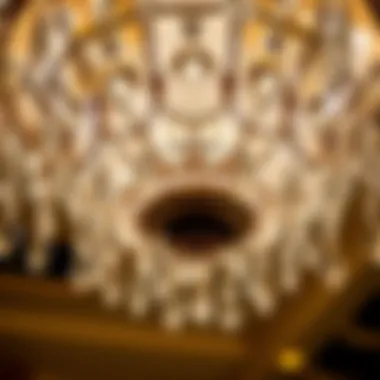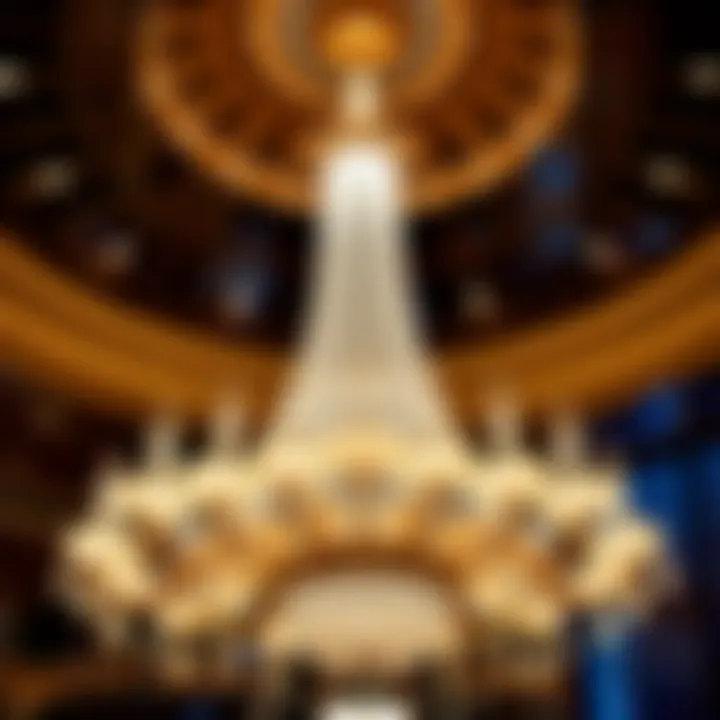The Cosmopolitan Chandelier: Luxury Redefined


Intro
The chandelier, often considered the crowning jewel of interior decor, has carved out a significant niche within cosmopolitan environments, particularly casinos. Here, luxury intertwines with experience, making these luminous installations not just visual spectacles but also vital aspects of the ambiance that shape visitors' feelings and actions. In this exploration, we will navigate through the multifaceted world of chandeliers, uncovering their storied history, the cultural significance they hold, and the impact they impart on those who encounter them.
With each sparkling crystal, each intricate design, the chandelier transforms mere spaces into realms of opulence. But why do these light fixtures elicit such strong emotions? What psychological triggers do they activate to define status and sophistication in bustling cosmopolitan locales? This article endeavors to delve into these questions, shedding light on the intricate dance of light and architecture that chandeliers perform in elevating an experience.
By pulling apart the various styles—from the classic grandeur of Baccarat’s creations to the modern, sleek designs of contemporary artists—we will examine their equivalence in creating atmosphere and mood.
As we embark on this journey, anticipate insights not just into the aesthetics of chandeliers but also into their nuanced role in the realm of casinos and beyond. You'll discover how they reflect more than just wealth; they act as a barometer for social standing, affecting perceptions and expectations.
Preface to the Chandelier Phenomenon
The world of chandeliers is more than just an exhibition of extravagant lighting; it's a reflection of an era informed by culture, luxury, and human creativity. As we delve into the realm of chandeliers, particularly in contemporary urban environments, one can pinpoint their significance in enhancing the ambience of casinos and similar establishments. These illuminating masterpieces serve not just as accessories, but as potent signifiers of status and artistry.
From the glimmering crystals that capture light in every flicker to the intricate designs that narrate stories, chandeliers have carved a unique position in urban culture. Visitors often find themselves captivated not merely by a striking visual display but also by the atmosphere it creates—a blend of luxury wrapped in layers of experience. As such, the exploration of chandeliers in this article will uncover the throbbing heart of what these fixtures represent amidst the hustle and bustle of modern life.
Understanding the Chandelier Within Urban Culture
In cities where dreams are spun into reality, chandeliers beam with social and economic significance. They often become symbols that transcend mere decorative elements. Take a stroll through any high-end casino, and you might notice how chandeliers establish a connection between wealth and artistry. They beckon patrons with promises of thrill, injecting the air with an unspoken elegance and gravitas. The style, be it a traditional French crystal chandelier or a modern metallic design, can evoke different emotions in visitors, molding their perceptions of the space around them.
Furthermore, chandeliers often push the narrative of status. They are not only adornments but badges of honor for establishments aiming to elevate their image in a competitive market. It's fascinating to observe how something as simple as lighting can convey complex messages about affluence and lifestyle.
The Role of Lighting in Modern Design
As the sun sets and the city skyline glimmers, the role of lighting transforms. It shifts from a mere necessity to a vital design component. Chandeliers, as prime examples of lighting design, integrate seamlessly into the overarching themes of modern architecture. Designers often use lighting to create lines, define spaces, and influence a visitor's journey through a venue.
Example elements that come to mind in this regard are:
- Mood Setting: Thoughtful placement of chandeliers can provoke specific emotions—opulence, warmth, or intimacy—all critical in a casino’s design.
- Spatial Illumination: Rather than simply lighting the floor, sophisticated chandeliers expertly highlight key areas, drawing attention to bars, gaming tables, and lounges.
- Focal Points: A chandelier can serve as a central focal point, anchoring a room's design while simultaneously enhancing its aesthetic value.
By marrying artistry with functionality, chandeliers elevate the design narrative, offering an experience that resonates far beyond the visual. This interplay between light, architecture, and emotional response ensures that chandeliers remain steadfast in the dialog of modern design—an enduring testament to the beauty of illuminating spaces.
Historical Context of Chandeliers
Understanding the historical roots of chandeliers is essential for grasping their evolution and significance in contemporary design, especially within luxurious urban settings such as casinos. These magnificent light fixtures are not merely decorative— they often carry with them stories of culture, artistry, and prestige. Through their transformation over time, chandeliers have mirrored societal trends, technological advancements, and shifts in tastes.
Historically, chandeliers were symbols of wealth, used as primary lighting sources in grand halls and elite residences. Initially made from basic materials, their designs blossomed into extraordinary artistry. By delving into the past, one can uncover how chandeliers have become synonymous with high culture and leisure, particularly in casino environments where opulence is paramount.
Evolution Through the Ages
The journey of chandeliers can be traced back to the Middle Ages when lighting was a necessity and a luxury. The earliest designs were rather crude, often constructed from wood or wrought iron, and primarily served to hold candles. However, it wasn't long before innovative minds began to play with their forms and materials. As crystal glass became more accessible in the 19th century, chandeliers saw a dramatic resurgence in style. This was a time when intricate facets began to catch light, scattering it in dazzling patterns across walls.
During the Baroque and Rococo periods, the chandelier experienced a renaissance. Elaborate embellishments became the norm, and these fixtures were characterized by their towering profiles and lavish decorations. The mere presence of a grand chandelier signaled a space of affluence. They hung over tables in opulent banquet halls, setting the ambiance for lavish feasts and celebrations.
The Industrial Revolution marked another pivotal moment in chandelier history. Mass production enabled a broader audience to experience the splendor of these fixtures, leading to varied designs that catered to different social classes. This democratization of luxury illuminated homes across Europe and America. The late 20th century saw a shift once again, with modern designers incorporating minimalist aesthetics, much in contrast with the grandiosity of previous eras. Today, chandeliers continue to adapt, blending tradition with contemporary design, seamlessly integrating into various environments.
Chandeliers in Royal and Elite Spaces
In royal palaces and exclusive venues, chandeliers live on as enduring symbols of luxury. These spaces often showcase some of the most extraordinary examples of chandelier craftsmanship. For instance, the famous Hall of Mirrors in the Palace of Versailles boasts a majestic chandelier that hangs majestically amidst gold leafing and opulent decor.
Beyond mere functionality, such chandeliers design a narrative of power and prestige. Their opulence signifies a certain status and is thought to enhance the experience of guests. In environments where high-stakes gambling takes place, the presence of magnificent chandeliers can elevate the expectation of luxury and thrill that patrons seek.
Their importance extends beyond aesthetics; psychological studies have shown that environments imbued with sophistication encourage patrons to spend more, as they feel enveloped by an atmosphere of privilege. It's fascinating how something as simple as lighting can influence feelings of comfort, status, and even risk-taking behavior, making chandeliers integral to the casino experience.


"In the world of high stakes and bright lights, a chandelier isn’t just a light—it’s a statement."
In summary, the historical context of chandeliers serves as a foundation for understanding their place in modern society. With centuries of evolution reflecting changing tastes and societal values, chandeliers are now more than just light fixtures; they embody an experience steeped in cultural significance.
Chandeliers in Casino Architecture
The role of chandeliers within casino architecture cannot be understated, as they serve as both a functional lighting source and a pivotal aesthetic component that enhances the overall visitor experience. These grand fixtures are more than mere decorations; they are intricate pieces that carry weighty symbolism and contribute to the ambiance found in such luxurious environments. In casinos, where every detail counts towards creating an unforgettable experience, chandeliers play a crucial role in defining the atmosphere while reinforcing themes of opulence and sophistication.
Design Principles and Aesthetics
When examining the design principles behind chandeliers in casinos, one must consider various factors including scale, form, material, and placement. The sheer size of chandeliers can set the tone for the entire space. For instance, in a venue such as the Bellagio in Las Vegas, chandeliers can be so large that they dominate the room and become an attraction in their own right.
- Scale: A large chandelier can create a focal point, drawing guests' eyes up and instilling a sense of wonder.
- Form: The shape of the chandelier often resonates with the casino's theme; from classic crystal designs to innovative modern forms, each configuration speaks to a unique aesthetic vision.
- Material Choices: Utilizing materials such as Murano glass or hand-cut crystals not only elevates the visual appeal but also serves to establish a standard of luxury. The choice of materials influences light reflection and refraction, which can subtly alter the mood of the space.
- Placement: Strategic positioning is paramount; placing chandeliers over high-stakes areas or main gaming floors heightens visibility, ensuring they are front-and-center in the patrons’ experience.
As a result of these principles, chandeliers are meticulously designed to complement the ultimate gambling environment, creating visual drama that enlivens the space and engages visitors.
Creating Atmosphere and Ambiance
In a casino setting, creating the right atmosphere is essential for influencing visitor behavior and enhancing overall engagement. Chandeliers heavily contribute to this ambiance in several critical ways:
- Lighting Dynamics: Soft, warm lights can create a welcoming environment, encouraging gamblers to linger longer, while brighter, more vibrant lights may energize patrons as they vie for luck at the tables.
- Elaborate Reflections: The reflective quality of materials like crystal can disperse light in a manner that casts sparkles across the room, adding to the allure and magic of the environment. This shimmer appeals not just to the eye, but also to emotions.
- Layered Lighting Schemes: Good design often employs multiple sources of light, with chandeliers acting as the centerpiece surrounded by ambient and accent lighting. This layering gives the illusion of depth and richness, tempting visitors to explore further.
- Emotional Engagement: A magnificent chandelier can instigate feelings of excitement or serenity, depending on its design and the interplay of light. It not only brightens the room; it can uplift spirits or evoke nostalgia, which is why casinos pay such close attention to their selection.
"The right chandelier does not simply light a room; it transforms the entire gambling experience into something enchanting and memorable."
In essence, the incorporation of chandeliers within casino architecture intertwines functionality with high-end design, creating an environment where luxury and excitement thrive. Understanding these elements invites a deeper appreciation for how artistry and craftsmanship merge to impact the overall experience and satisfaction of the casino-goer.
Materials and Craftsmanship
The intricate nature of chandeliers goes far beyond mere aesthetics; it embodies a fusion of materials and craftsmanship that speaks volumes about the environment in which these grand pieces reside. Materials are the backbone of every chandelier, influencing not only its appearance but also its durability and the aura it emits in a luxurious space, particularly within cosmopolitan settings like casinos.
Craftsmanship, on the other hand, denotes the skill involved in bringing these materials to life. It’s the artist's touch that separates an ordinary chandelier from an exceptional one. High-quality materials, coupled with meticulous craftsmanship, create a statement piece that not only illuminates but also transforms the ambiance of any room into an experience.
Among the various materials employed, two stand out prominently: crystal and glass. Each of these materials offers distinctive qualities and serves different purposes in chandelier design.
Crystal vs. Glass: A Comparative Analysis
When it comes to creating a chandelier that oozes opulence, the choice of material is pivotal.
- Crystal provides greater depth and brilliance to the light. It refracts more effectively than glass, resulting in a dazzling display of colors when illuminated. The lead content in crystal enhances its weight and clarity, making it a preferred choice for luxurious designs. Furthermore, the cutting techniques applied to crystals create intricate patterns that can turn a chandelier into a true work of art.
- Glass, while it might lack the heavy luster of crystal, offers flexibility and innovative designs. Glass chandeliers can be shaped and colored in myriad ways, giving designers a canvas of possibilities. They’re often lighter and easier to handle compared to their crystal counterparts, which can be a practical consideration in larger installations.
The decision often comes down to the environment in which the chandelier will be placed. Casinos, with their vibrant energy, often favor crystal because of how it affects the lighting, creating an inviting yet sophisticated atmosphere.
The choice between crystal and glass is more than aesthetic; it’s about crafting an atmosphere that resonates with the intended experience of the space.
Innovative Techniques and Treatments
The evolution of chandelier design is driven not just by the materials used but also by innovative techniques and treatments that revolutionize the art of chandelier crafting. Today, there are several methods that enhance both functionality and design.
- LED Integration is a significant advancement. Not only does it substantially reduce energy consumption, but it also allows for color customization which can dynamically alter the ambiance of a casino floor. This melding of technology with traditional design caters to a modern audience that values efficiency without sacrificing elegance.
- Water-jet Cutting has transformed how materials are shaped. This technique allows for ultra-precise cuts in glass or crystal that can be coupled with other treatments like acid etching. Such precision offers designers the ability to create unique, bespoke pieces that stand out.
- Coating Treatments such as anti-tarnishing and anti-static finishes not only keep chandeliers looking pristine but also enhance their durability. Given the high foot traffic in casinos, chandeliers require coatings that protect against dust and grime accumulation, ensuring they remain a centerpiece rather than a source of maintenance headaches.
As we delve deeper into the world of chandelier design, it becomes evident that both materials and craftsmanship play critical roles in creating experiences that are not only visually stunning but also meaningful. The ongoing innovation in techniques ensures that every installation carries with it a stamp of modernity while honoring traditional craftsmanship.
Psychological Impact on Visitors


When delving into the world of chandeliers, it’s intriguing to consider their unseen role in shaping the experiences that visitors have in high-class establishments like casinos. The way chandeliers interact with human emotions and perceptions is profound. They do far more than merely hang from ceilings; they weave into the psyche of visitors and can influence everything from mood to decision-making.
Influencing Behavior and Decision-Making
It’s no secret that lighting plays a crucial role in how individuals navigate spaces, especially in places designed for high-stakes gambling. Chandeliers serve as subtle cues that can significantly affect behavior. A well-lit environment draws gamblers in and can hold their attention far longer than a dimly lit room. This creates a sense of excitement and encourages players to stay and play, thus leading to potentially larger bets.
The type of light emitted by chandeliers, whether soft and warm or bright and invigorating, can dictate how confident or relaxed visitors feel. For example, a warm glow might make a player feel at ease, nudging them towards a longer stay, while a more intense light might evoke energy and risk-taking behavior.
Additionally, the strategic placement of chandeliers can guide foot traffic within the casino. When visitors see a stunning chandelier shimmering at a distance, it pulls them in, like moths to a flame, enhancing not just their experience but also the establishment's profitability.
Perceptions of Luxury and Affluence
Chandeliers intrinsically symbolize luxury and opulence, and their presence in casinos is no accidental decision. Visitors often equate grandeur with status and class. When one steps into an establishment adorned with dazzling chandeliers, the immediate perception is that they are entering a high-end and exclusive venue. In this way, chandeliers act as beacons of affluence.
Studies show that environments filled with luxurious decor can elevate a visitor's self-assessment, making them feel more prosperous and successful, even if only temporarily. The sparkles of the crystals or the elegance of the design can trigger feelings of wealth, thus influencing decisions and betting behaviors. A player might feel psychologically compelled to increase their wagers in a setting that feels luxurious and prestigious, merging the experience of gambling with the allure of glamour.
"The atmosphere surrounding a chandelier impacts not only how guests perceive luxury but also how they choose to engage with the surroundings."
Iconic Chandeliers in Notable Casinos
When you step into a casino, the atmosphere is often a cacophony of lights, sounds, and movement. Yet, amidst the bustle, certain features stand out—none more so than the iconic chandeliers that grace these opulent settings. These lighting installations are not just ornaments; they are deliberate design choices that enhance the overall experience of gambling and leisure. The right chandelier can transform an otherwise ordinary space into a regal arena of excitement and indulgence.
Case Study: The Cosmopolitan of Las Vegas
The Cosmopolitan of Las Vegas is a shining example of how a well-placed chandelier can create a captivating focal point. Upon entering the casino, visitors are met with the stunning "Chandelier"—a three-layered marvel that humbles any onlooker. This installation is not merely about aesthetics. Measuring an impressive 40 feet tall and made from over 2 million crystals, it communicates a sense of extravagance that is nearly palpable.
The various tiers of the chandelier are designed to provide different atmospheres within the same space. Guests may enjoy a drink at the bar beneath it, basking in the soft glow of the lower layer or ascend to the second tier for a more intimate dining experience, all while being enveloped by the seamless fusion of light and luxury. The construction comprises an intricate dance of form and function, where each crystal reflects not just light, but the very essence of the extravagant Las Vegas lifestyle. The experience is not just visual; it resonates emotionally, influencing how a visitor engages with the space and the activities within it.
Comparative Analysis with Other Luxury Venues
Besides The Cosmopolitan, other luxury casinos have invested heavily in signature chandeliers. For instance, the Bellagio, also in Las Vegas, features the breathtaking "Fiori di Como" by artist Dale Chihuly. This piece, showcasing over 2,000 hand-blown glass blossoms, also serves a dual purpose: it dazzles the eye while setting a relaxed yet upscale atmosphere in the lobby.
In contrast, the Wynn Las Vegas boasts chandeliers that exude minimalism yet sophistication, prioritizing craft and artistry. Its simplistic designs blend seamlessly with the modern décor, evoking an upscale yet accessible ambience. The choice between ornate vs. minimalist designs shows the diverse interpretations of how chandeliers can engage patrons across different casinos.
Both cases indicate that the placement of chandeliers in such casinos is not haphazard; each piece has been installed to support the venue's branding and ambience strategy. The visual narratives these chandeliers create enhance the segmented spaces and define the overall experience for patrons.
By understanding the importance of these installations, one can appreciate their role in the larger dialogue about architecture and experience in cosmopolitan environments.
"Chandeliers shine a light not just on the room but also on the experience."
For more insights on chandeliers in architectural design, consider visiting Wikipedia or Britannica.
Future Trends in Chandelier Design
The future of chandelier design is akin to a kaleidoscope, constantly evolving with the times yet holding onto the essences of luxury and artistry. In a world increasingly focused on sustainability and technology, the chandelier continues to capture the imaginations of designers and consumers alike. This section scrutinizes how these trends are shaping the landscape of urban design, particularly in spaces frequented by gamblers, poker players, and casino enthusiasts. The relevance of this topic cannot be overstated as it encapsulates the ongoing dialogue between aesthetic allure and contemporary values.
While chandeliers have long been symbols of opulence, their place in modern settings is being reimagined. Design choices reflect more than just luxury; they now incorporate elements that speak to the environment and evolving consumer priorities. As such, understanding these trends is vital for professionals in the gaming and hospitality sectors.
Sustainability and Eco-Conscious Choices
Sustainability is no longer just an afterthought; rather, it’s a driving force in chandelier design. More designers are opting for materials that are environmentally friendly, such as reclaimed wood and eco-friendly metals. Innovations in manufacturing methods also play a significant role. For instance, LED technology not only reduces energy consumption but also shifts the way light interacts with materials, creating an ambiance that feels both sophisticated and kind to the planet.
Consumers today, including casino patrons, tend to gravitate towards establishments that reflect their own ideals—exemplifying social responsibility and eco-friendliness. Incorporating sustainable designs not only garners customer loyalty but can also offer long-term cost savings through reduced energy expenses.


"In the game of life, just like in gambling, making wise choices leads to favourable outcomes; that applies to the environment, too."
Technological Advances in Lighting
The marriage of technology and art is transforming chandeliers in ways that were once the stuff of dreams. Smart lighting systems are at the forefront of this transition, allowing environments to dynamically shift from a vibrant game atmosphere to a tranquil, sophisticated lounge space with just a click. Such flexibility adds layers of experience for casino visitors.
Smart chandeliers can be programmed to change brightness, color, and even patterns, enhancing not just aesthetic appeal but also visitor engagement. The integration of IoT technology offers real-time monitoring, enabling maintenance notifications and energy usage statistics, representing a new frontier in luxury chandeliers that aligns with modern utility needs.
Cultural Perspectives on Chandeliers
Chandeliers have transcended their original purpose of lighting, evolving into poignant symbols of culture and social status. Understanding these cultural perspectives not only enhances our appreciation for their design but also highlights their impact within society. Particularly in cosmopolitan settings, chandeliers reflect values, beliefs, and historical narratives that vary from one culture to another. The importance of this topic is multifaceted, encompassing themes of identity, status, and artistic expression. Here, we delve into the symbolism and the historical contexts that shape how different societies perceive chandeliers, paying special attention to their presence in both colonial and post-colonial settings.
Symbolism Across Different Societies
In various cultures, chandeliers are often associated with wealth and elegance. In Western contexts, the grand crystal chandelier has long been seen as an emblem of opulence, often gracing the ballrooms and dining halls of the affluent. This style communicates a lavish lifestyle, suggesting that one's home is not merely a dwelling but a showcase of status and taste.
Conversely, in Eastern cultures, chandeliers may symbolize enlightenment and knowledge. Houses adorned with ornate fixtures often mirror a quest for wisdom, with the intricate designs representing the complexity of life's journey. Countries such as India see chandeliers made of colorful glass or metal, resonating with the rich textile and artistic visual heritage prevalent in the region.
- **Cultural Significance:
- Opulence in Western societies
- Enlightenment in Eastern traditions**
This symbolic dichotomy underscores how chandeliers serve as powerful conduits of cultural narratives, be it flaunting wealth or embodying personal growth. It's a succinct reminder that objects we often take for granted can hold profound meanings, shifting in significance as they travel across cultural landscapes. The views surrounding chandeliers are as varied as the societies that embrace them, making their story as intricate as the designs themselves.
Chandeliers in Colonial and Post-Colonial Settings
The narrative of chandeliers gains even more depth when we consider colonial and post-colonial contexts. During colonial times, European powers often installed extravagant chandeliers in newly established territories, using them as instruments of dominance. These installations were not simply decorative; they were statements proclaiming the influence of colonizers and their cultural superiority. In places like India, British settlers adorned their bungalows with chandeliers to convey a sense of authority, visually detaching themselves from the local populace.
In the post-colonial era, however, the symbolism attached to these fixtures began to shift. Descendants of colonized nations started reclaiming the chandelier's prestige, reimagining its meaning within their own cultural frameworks. For instance, in contemporary India, designers are blending traditional motifs with modern techniques, producing chandeliers that honor indigenous artistry while also appealing to global sensibilities.
- **Historical Context:
- Colonizers used chandeliers as symbols of dominion
- Post-colonial reclamation and reinterpretation**
This transformation illustrates how various communities have navigated the legacies of the past, redefining what chandeliers represent in the context of cultural identity and ownership. The evolution of chandeliers from tools of colonial power to expressions of localized pride demonstrates their adaptability and enduring relevance in urban design.
"Chandeliers reflect not just light, but the aspirations and narratives of the societies that embrace them."
In sum, the cultural perspectives on chandeliers reveal a dynamic interplay of history, identity, and artistic expression. By examining these facets, we gain a richer understanding of how such objects can function as reflections of societal values, enhancing our appreciation of their intricate designs and profound significance.
Epilogue: The Lasting Impact of Chandeliers in Cosmopolitan Design
The role of chandeliers in cosmopolitan environments cannot be overstated. These artistic lighting fixtures serve as a bridge between grandeur and functionality, creating a dialogue between aesthetics and ambiance. As previous sections explored the historical roots, craftsmanship, and psychological influence of chandeliers, the concluding reflection brings into focus the overarching significance they hold in urban design today.
Chandeliers are more than just decorative elements; they are iconic symbols that capture the essence of luxury and sophistication. In spaces where the vibrancy of life meets the quiet yearning for an elevated experience, these lighting fixtures amplify the emotions that dwell within. Their intricate designs can woo even the most discerning eye, while their glow can instill a feeling of opulence and warmth. Particularly in casinos, where the stakes are high and the atmosphere electric, chandeliers play an essential role, transforming mundane venues into captivating experiences where guests feel as if they are part of something much larger than themselves.
"A chandelier can make a statement, or it can be the backdrop for unforgettable memories. In the cosmopolitan scene, its impact lasts far beyond the moment."
Reflections on Design and Culture
Diving deeper into the cultural tapestry woven by chandeliers, one can see how these fixtures resonate with various societal norms and historical contexts. For instance, in a casino setting, the grandeur of a chandelier often reflects not just wealth but also a sense of belonging to a specific social class. It's not uncommon to find that the design of these lighting pieces draws upon the artistic styles and craftsmanship of their times, from Baroque flamboyance to sleek modern minimalism.
Moreover, how chandeliers are perceived can differ vastly between cultures. In some families, a chandelier symbolizes prosperity and faith in what the future holds. Conversely, in minimalist cultures, the same object might stand as a reminder of excess and the untamed spirit of consumerism. This duality points to the complex relationship between design and the values it represents, leading us to ponder the implications of luxury attachments.
Looking Ahead: The Future of Lighting in Urban Spaces
As we gaze into the future, the evolution of chandelier design appears promising and innovative. With a growing emphasis on sustainability, architects and designers are now considering eco-friendly materials and energy-efficient lighting solutions. The integration of smart technology into chandelier designs will bring about transformative changes, where lighting can adapt to different moods or occasions—think of chandeliers that change colors based on the time of day or events occurring within the venue.
Urban environments are embracing these advancements is crucial. As cities push toward greener futures, the demand for luxurious yet responsible design will likely elevate the status of the chandelier as both a decoration and an experience.







